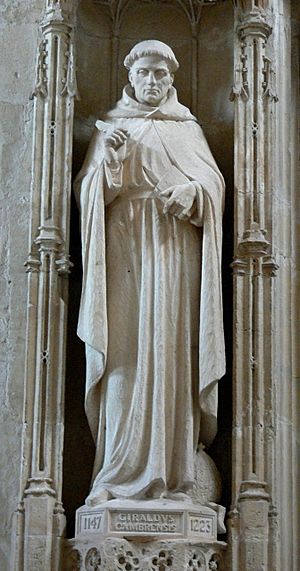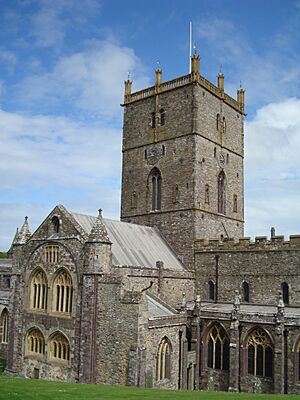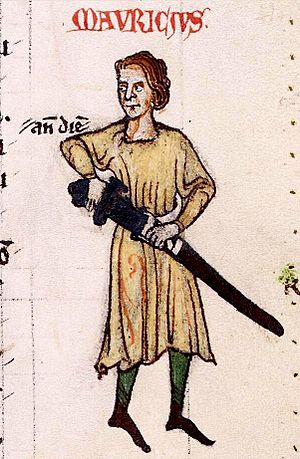Gerald of Wales facts for kids
Quick facts for kids
Gerald of Wales
|
|
|---|---|

Statue in St Davids Cathedral
|
|
| Born | Gerald de Barri c. 1146 Manorbier Castle, Pembrokeshire, Wales |
| Died | c. 1223 (age about 77) probably Hereford, England |
| Occupation | Clergyman |
| Language | Latin |
| Nationality | Cambro-Norman |
| Alma mater | University of Paris |
| Notable works | Topographia Hibernica Itinerarium Cambriae Descriptio Cambriae De principis instructione |
Gerald of Wales (also known as Latin: Giraldus Cambrensis or Welsh: Gerallt Cymro) was an important priest and historian from the Middle Ages. He was born around c. 1146 and died around c. 1223.
Gerald was a royal clerk, which meant he worked for the king and important church leaders. This job allowed him to travel a lot and write many books. He studied in France and visited Rome several times, even meeting the Pope! He hoped to become the Bishop of St Davids in Wales, but he was never chosen for this role. His last official job was as the Archdeacon of Brecon. After that, he spent the rest of his life studying and writing. Many of his writings are still around today.
Contents
Life Story
Growing Up

Gerald was born around c. 1146 at Manorbier Castle in Pembrokeshire, Wales. His family had both Norman and Welsh roots. His father was a powerful Norman baron in Wales. His mother was related to the Welsh royal family. This meant Gerald had important connections on both sides.
He went to school at a monastery in Gloucester, England. Then, he studied in Paris, France, from about 1165 to 1174. There, he learned important subjects like grammar, logic, and public speaking.
After his studies, Gerald worked for the Archbishop of Canterbury. He helped with church matters in Wales. In 1174, he became the Archdeacon of Brecon. This was an important church position.
A Dream Not Realized
When his uncle, the Bishop of St Davids, died in 1176, Gerald was chosen by the church leaders to be the next bishop. St Davids wanted to be independent from the Archbishop of Canterbury. The leaders thought Gerald would help them achieve this.
However, King Henry II of England did not agree. He chose someone else, Peter de Leia. The King worried that Gerald, with his Welsh family ties, might cause trouble. Gerald was very disappointed. He went back to the University of Paris to study more. He learned about church law and religion.
Amazing Journeys
In 1184, Gerald became a royal clerk and chaplain for King Henry II. He even helped settle arguments between the King and Welsh Prince Rhys ap Gruffydd.
In 1185, Gerald traveled to Ireland with the King's son, John. This trip inspired him to start writing books. His first major work was Topographia Hibernica (which means "Topography of Ireland"). It described his journey and what he saw in Ireland. He later wrote Expugnatio Hibernica, about the Norman conquest of Ireland. These books show his great knowledge, but also his strong opinions about different people.
In 1188, Gerald joined the Archbishop of Canterbury on a trip through Wales. Their goal was to recruit people for the Third Crusade. Gerald wrote about this journey in Itinerarium Cambriae ("Journey through Wales"). Later, he wrote Descriptio Cambriae ("Description of Wales") in 1194.
These two books about Wales are very important historical records. They describe Welsh and Norman cultures, even though Gerald's views could be biased. We don't know if Gerald spoke Welsh, but he seemed to know a lot about the language and customs.
Gerald was offered several important church jobs, like bishoprics in Ireland and Wales. But he turned them all down. He still hoped to become the Bishop of St Davids.
Trying Again for St Davids

When Bishop Peter de Leia died in 1198, the church leaders in St Davids again chose Gerald as their bishop. But the Archbishop of Canterbury, Hubert Walter, still refused to approve him.
Gerald traveled to Rome three times (1199-1200, 1201, 1202-3) to ask Pope Innocent III for help. He argued that St Davids should be an independent archbishopric, just like Canterbury. He wrote books like De jure Menevensis Ecclesiâ to support his case.
The Welsh princes, like Llywelyn the Great, supported Gerald. But King John sided with the Archbishop of Canterbury. In 1202, Gerald was even accused of causing rebellion in Wales.
Finally, in 1203, the Pope decided to cancel both elections. He appointed someone else, Geoffrey of Henlaw, as Bishop of St Davids. Gerald was very upset. He famously wrote to the Pope, asking why he couldn't be a bishop in Wales just because he was Welsh. He said he was from both Welsh princes and Norman barons. After this long struggle, Gerald resigned from his position as Archdeacon of Brecon.
Later Years
Gerald spent the rest of his life studying and writing. He revised his earlier works about Ireland and Wales. He also wrote books about religious teachings and politics. He died around 1223, probably in Hereford, England. Some say he is buried at St Davids Cathedral.
There is a statue of Gerald in City Hall, Cardiff. He is remembered for his important writings about Wales.
His Writings
Gerald wrote in excellent Latin, showing he knew a lot about ancient Roman authors. He was seen as a very smart scholar in his time. His writings fill about ten large books today! Gerald had strong opinions and sometimes criticized his enemies. But he was also very curious and wrote down many interesting details about daily life and different cultures.
His most famous works are about Wales and Ireland. His two books about Wales, Itinerarium Cambriae and Descriptio Cambriae, are especially important. They tell us a lot about Welsh history, geography, and the relationship between Welsh and English cultures. Even though Gerald wanted an independent Welsh Church, he also respected Norman rule. He thought Normans were more civilized than the Welsh.
Gerald wrote that if the Welsh people stayed united, they would be unbeatable. He also said that Welsh fighters fought for their country, unlike English soldiers who fought for money.
Gerald also wrote about nature. He was a good observer, but sometimes he mixed facts with legends. For example, he described an osprey fishing but added a mythical detail about one of its feet. His descriptions of Irish wildlife have some mistakes, but they still give us a valuable look at animals in Ireland in the 1180s. He noted that common kingfishers were not in Ireland then, but white-throated dippers were very common. He also saw many birds of prey, like golden eagles and Eurasian sparrowhawks, which he said were more common in Ireland than in England.
List of Works

- Topographia Hibernica ("Topography of Ireland", 1187)
- Expugnatio Hibernica ("Conquest of Ireland", 1189)
- Itinerarium Cambriae ("Journey through Wales", 1191)
- Descriptio Cambriae ("Description of Wales", 1194)
- De instructione principis ("Education of a Prince")
- De rebus a se gestis ("Autobiography" - his life story)
- De iure et statu Menevensis ecclesiae ("Rights and privileges of the Church of St Davids")
- Gemma ecclesiastica ("Jewel of the Church")
- Speculum ecclesiae ("Mirror of the Church")
- Symbolum electorum
- Invectiones
- Retractationes
- Speculum duorum ("A Mirror of Two Men")
- Life of St Hugh of Lincoln
- Life of Geoffrey, Archbishop of York
- Life of St Ethelbert
- Life of St Remigius
- Life of St David
Lost Works
Some of Gerald's writings have been lost over time:
- Vita sancti Karadoci ("Life of St Caradoc")
- De fidei fructu fideique defectu ("About the Fruit of Faith and the Lack of Faith")
- Totius Kambriae mappa ("Map of all Wales", around 1205)
Online Books
- The Historical Works of Giraldus Cambrensis (This link has English translations of some of his books.)
See also

